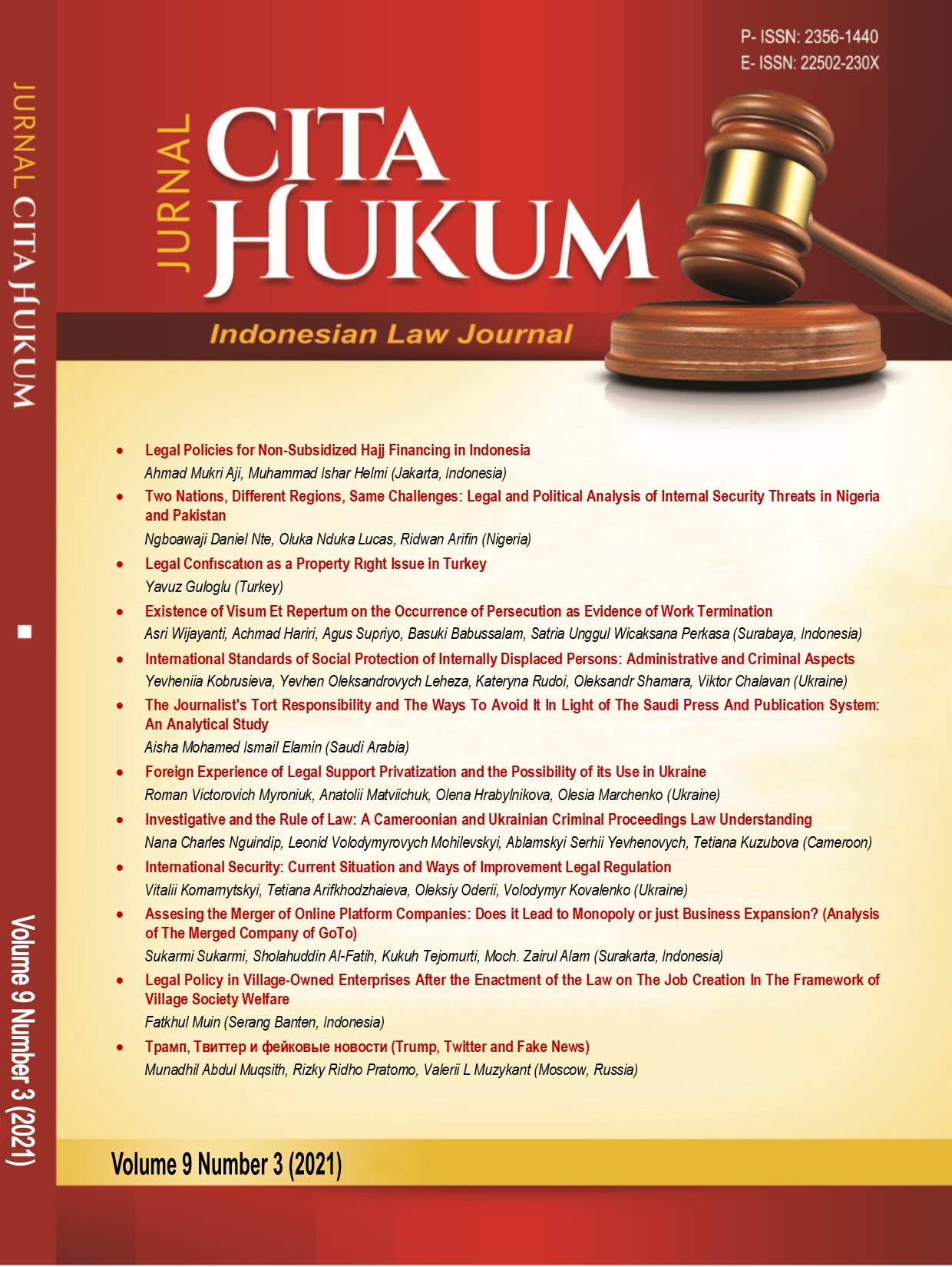Динамика религиозного экстремизма в России в богословских, правовых и психологических подходах к социальной и личностной; Dynamics of Religious Extremism In Russia In Theological, Legal and Psychological Approaches to Social and Personal
DOI:
https://doi.org/10.15408/jch.v10i2.27803Abstract
After the collapse of the Soviet Union in the post-Soviet era, a spiritual vacuum was formed in the conditions of deterioration of the political and economic situation. In the North Caucasus region, during the formation of the Russian state, it was quickly filled with religion: Wahhabism emerged, spread and increasingly declared itself religious extremism. Several terrorist attacks have occurred not only in the North Caucasus, but also in several Russian cities. This article describes the dynamics of religious extremism in Russia from the point of view of the theological, legal and psychological approach to social and personal. With regard to the soft approach, Russia can implement programs of deradicalization and counter-radicalization. In this regard, Russia may create a National Agency for Combating Terrorism and launch a deradicalization project and create a Deradicalization Center for convicted terrorists. Efforts to prevent the development of religious extremism in Russia are being undertaken not only with a legal approach, but also with a theological approach, since it is connected with Islamic concepts.
References
Alkatiri, W. (2018). Religious extremism di era post-everything: Perspektif teori kritis (Cetakan I). Akademika.
Allport, G. W., & Ross, J. M. (1967). Personal religious orientation and prejudice. Journal of Personality and Social Psychology, 5(4), 432–443. https://doi.org/10.1037/h0021212
Arweck, E., & Nesbitt, E. (2010). Young People’s Identity Formation in Mixed-Faith Families: Continuity or Discontinuity of Religious Traditions? Journal of Contemporary Religion, 25(1), 67–87. https://doi.org/10.1080/13537900903416820
Buana, D. R., & Juwita, M. N. (2021). Government Policy in Overcoming Religious Extremism in Indonesia: A Multidisciplinary Review between Public Administration and Psychology. RUDN Journal of Public Administration, 8(4), 423–433. https://doi.org/10.22363/2312-8313-2021-8-4-423-433
Buana, D. R., & Lukyanov, O. V. (2020). Understanding Violent Religious Behavior in Indonesia; From the Concept to the Prevention. Jurnal Cita Hukum, 8(1), 1–16. https://doi.org/10.15408/jch.v8i1.15003
Delamater, J. D., Myers, D. J., & Collett, J. L. (2018). Social Psychology (8th ed.). Routledge. https://doi.org/10.4324/9780429493096
Grajales, T. E., & Sommers, B. (2016). Identity Styles and Religiosity: Examining the Role of Identity Commitment. Journal of Research on Christian Education, 25(2), 188–202. https://doi.org/10.1080/10656219.2016.1191394
McGregor, I. (2004). Zeal, Identity, and Meaning: Going to Extremes to Be One Self. In Handbook of Experimental Existential Psychology (pp. 182–199). Guilford Press.
Milla, M. N., Putra, I. E., & Umam, A. N. (2019). Stories from jihadists: Significance, identity, and radicalization through the call for jihad. Peace and Conflict: Journal of Peace Psychology, 25(2), 111–121. https://doi.org/10.1037/pac0000371
Park, C. L. (2007). Religiousness/Spirituality and Health: A Meaning Systems Perspective. Journal of Behavioral Medicine, 30(4), 319–328. https://doi.org/10.1007/s10865-007-9111-x
Peek, L. (2005). Becoming Muslim: The Development of a Religious Identity. Sociology of Religion, 66, 215–242.
Peracha, F. N., Ayub, A., Khan, R. R., Farooq, Z., & Zahra, A. (2017). Development and Validation of Indigenous Violent Extremism Beliefs Scale (VEBS). Journal of Psychology and Behavioral Science, 5(1), 53–62. https://doi.org/10.15640/jpbs.v5n1a7
Spaaij, R., & Hamm, M. S. (2015). Key Issues and Research Agendas in Lone Wolf Terrorism. Studies in Conflict & Terrorism, 38(3), 167–178. https://doi.org/10.1080/1057610X.2014.986979
Злоказов, К. В., Лату, М. Н., & Тагильцева, Ю. Р. (2021). ВЛИЯНИЕ ИДЕНТИЧНОСТИ НА ФОРМИРОВАНИЕ ЭКСТРЕМИСТСКИХ УСТАНОВОК: ЭМПИРИЧЕСКОЕ ИССЛЕДОВАНИЕ (ПСИХОЛОГО-ЛИНГВИСТИЧЕСКИЙ ПОДХОД). Сибирский Психологический Журнал, 79, 153–167.
Рязанов, Д. С. (2014). Религиозный экстремизм, религиозно-политический экстремизм и религиозный фундаментализм: Общее, особенное, единичное. Известия Иркутского Государственного Университета. Серия: Политология. Религиоведение, 7, 178–185.
Хаустова, Н. А. (2018). Идеологические и психологические аспекты изучения религиозного экстремизма. Вестник Полесского Государственного Университета. Серия Общественных и Гуманитарных Наук, 1, 47–50.
Муслимов С.Ш. (2012). Идеологические основы религиозно-политического экстремизма на Северном Кавказе X. Исламоведение, 4, 41–45.
Шамаев Артур Мурадинович. (2015). Некоторые особенности становления экстремизма в Северо-Кавказском регионе. Общество: Философия, История, Культура, 1, 38–40.
Рамазанов Рашид Омариевич. (2018). ПРИЧИНЫ РАДИКАЛИЗАЦИИ МУСУЛЬМАН СЕВЕРНОГО КАВКАЗА (НА МАТЕРИАЛАХ РЕСПУБЛИКИ ДАГЕСТАНА). ACTA HISTORICA: Труды По Историческим и Обществоведческим Наукам, 1, 154–159.
«Запрет ваххабизма может ударить по самому ДУМ РТ». (n.d.). Retrieved June 21, 2022, from https://www.business-gazeta.ru/blog/377404
самых известных “русских мусульман” - Р.А. Силантьев - читать, скачать. (n.d.). Retrieved June 21, 2022, from https://azbyka.ru/otechnik/religiovedenie/100-samyh-izvestnyh-russkih-musulman/#0_7
“Их невозможно запретить”. Почему мусульмане ссорятся из-за ваххабитов - РИА Новости, 24.04.2018. (n.d.). Retrieved June 21, 2022, from https://ria.ru/20180424/1519253978.html
ПРОТИВОДЕЙСТВИЕ ТЕРРОРИЗМУ И ЭКСТРЕМИЗМУ. (n.d.). Retrieved June 20, 2022, from https://arbat.mos.ru/countering-extremism/
Терроризм в новейшей истории России – Картина дня – Коммерсантъ. (n.d.). Retrieved June 20, 2022, from https://www.kommersant.ru/doc/5076469












